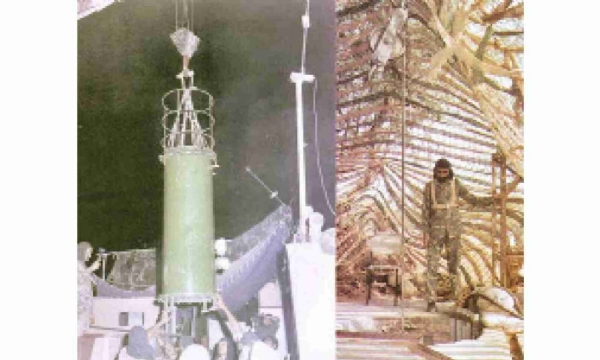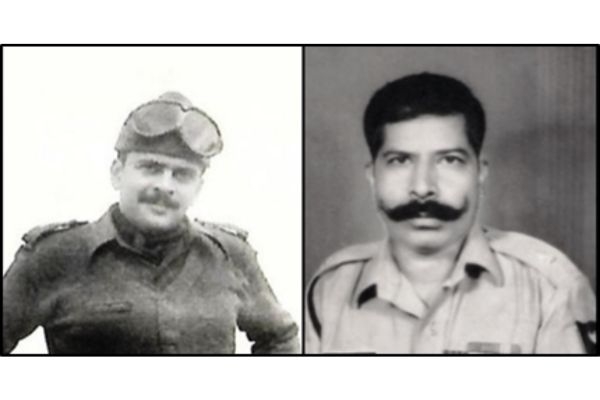Sinking Shafts for Pokhran-II Nuclear Tests: A First-Person Account
Part II – Commencement of Digging
Total Views |
In January 1981, 113 Engineer Regiment was detailed to sink two 500- feet deep L-shaped shafts for conducting nuclear tests in the Pokhran Ranges. It was an unprecedented assignment – no country has ever asked its army to sink such deep shafts. For, shaft-sinking is a highly specialised task. It requires domain knowledge, experience and special equipment. An engineer regiment possesses none. This first-person narrative is a part of the serialised reminiscence of the challenges faced. The first article of the series is available at Selection of Sites.
Self-belief, indomitable spirit, never-say-die approach and ingenuity helped the Regiment overcome all odds. As the saying goes – “Histories are scripted by the audacious”.

Once the go-ahead was received, the challenging assignment was undertaken in all earnest. Two task forces were constituted, one for each shaft site. Task Force ‘Blue Fox’ consisted of 418 Field Company, supplemented by a platoon of 109 Engineer Regiment under Lieutenant Ashok Srivastava. 358 Field Company constituted Task Force ‘Sand Grouse’. It was reinforced by a platoon of 419 Field Company under Captain NPS Chauhan. Maj S Jagannathan and I were the two Task Force Commanders.

(Task Force Commanders: Major Mrinal Suman and Major S Jagannathan)
Movement from Jodhpur to the camp site commenced in February 1981. Troops moved in small groups in a staggered manner over a period of 10 days, to make it appear as a routine area-familiarisation exercise. As extensive preparatory work had already been done to demarcate various locations within the camp area and guides posted along the route, troops moved in with military precision. No time was wasted in settling down. At our work site, we hoisted a flag of Baba Ramdev, the ruling deity of the desert, to remain under his benevolent protection. In hind sight, one feels convinced that the regiment was truly blessed: we did not have a single casualty despite many close shaves. Divine benediction kept us safe.
It took us quite some time to locate the iron pickets that we had earlier driven as markers for the selected sites. They had got buried in sand and the surrounding landscape had changed considerably due to drifting sand. Mine detectors had to be brought from Jodhpur to locate them. Before commencing digging, a small religious ceremony was held.
_202402231243309104_H@@IGHT_400_W@@IDTH_600.jpg)
With the help of a string and a peg, diameter of the shaft was marked. To fix extremities, a number of spikes were driven on the circumference. Digging commenced with picks and shovels. Here was a nuclear power with ambitions of mastering thermo-nuclear fusion, preparing a test site with primitive picks and shovels. We knew of no other way of digging. Notwithstanding the non-availability of the required where-with-all, excitement was palpable in the air.
All soldiers knew that the task assigned to the regiment was of national importance but the exact nature remained in the realm of speculation. A number of briefings were held of the troops to emphasise need for secrecy and safety. No cameras were allowed in the camp.
_202402231244131138_H@@IGHT_400_W@@IDTH_600.jpg)
For a few days, hauling of the dug earth was done manually with mortar pans and aluminium ladders. Thereafter, the unit crane was deployed with a modified coal-tar drum. Soon the crane rope reached its limit. We decided to use the dozer cable. A tripod gantry with blocks and tackles was erected to hoist a pulley system. Reeving was done by threading the winch-drum cable of a dozer. A larger semi-elliptical bucket was fabricated for removing earth. Such expedients can at best be of interim help. The dozer cable had limited length and worse, the wire-rope started fraying with strands coming apart. In fact, it was ill-suited for the task as the bucket used to swing wildly due to the wire-rope lacking non-twist construction.
After having cleared the sand over-burden, we met conglomerate consisting of gravel, sand-stone and silt-stone. We also encountered shale, a fine-grained clastic sedimentary rock. It is a mudstone that is fissile and laminated. Instability of the shaft walls became a matter of concern. Loose or unstable portions often fell down due to the vibrations caused by the pneumatic drills. During Pokhran-I, within one month of commencing digging, loose shale strata had fallen on the digging party, killing one and injuring four persons. Criticality of shaft stability was thus, well understood by us. At deeper depths, a cave-in could bury the working party alive.
In the absence of anything better, we started carrying out revetment of walls with flattened CGI sheets and iron pickets. With increasing depth, they proved grossly inadequate. We also tried to anchor wire mesh with rock-bolts on the walls to trap falling stones. It also proved to be of little use. Blasts used to loosen rocks along the natural cracks on the walls, uprooting the mesh. Even soil stabilisation through grouting was tried but to no avail.
Choice of shaft lining is a critical decision and depends on the nature of the rock strata. In some shafts, lining is done with precast concrete segments and shotcrete. Concrete is highly reliable but is normally used for shafts that are permanent or long-lasting. It is an expensive and time-consuming option. In our case, the shafts were required urgently and for one-off use only. We were at our wit’s end.
_202402231245013174_H@@IGHT_400_W@@IDTH_600.jpg)
After much deliberation, we hit upon a unique system of having prefabricated 2 feet high and 3 feet long steel jackets in the form of segments of a circle. These could be easily lowered into the shafts and bolted together to form a circular steel liner. For ease of fitting, we resorted to elliptical holes. Provision was made to drive rock bolts through the jackets for proper anchoring. Jackets also lent themselves to grouting to block water ingress. After every 10 feet of depth, we had to pause to stabilise the shaft walls with steel jackets and rock-bolts. This innovation proved highly successful and we kept using them till the end.
For deep shafts, collars have to be cast with heavy reinforced concrete in multiple tiers/levels for the needed stability. Shaft collars are also called ‘bank’ or ‘deck’ in mining manuals. Captain VG Gole was tasked to design the collar for soil stability. Stressing the overriding importance of secrecy, he was forbidden to use the services of any draftsman or typist.
The designed RCC collar was of 12 feet inner diameter and 16 feet depth. The wall thickness was one foot. After removing the top cover of sand to a depth of 15 feet, screed concrete was spread below, reinforcement steel positioned and concrete M20 poured.
_202402231246089272_H@@IGHT_400_W@@IDTH_600.jpg)
After our failed experiments with dozer cables, we realised that we needed a proper haulage system consisting of a winch drum with gear box and motor to haul a heavy bucket with SWR over a pulley mounted on a frame over the shaft. Efforts to procure one from the mines did not fructify as two years lead time was required by the manufacturers, which we could not afford. The local railway workshop was requested to design a system for us. They were very helpful but their design turned out to be far too unwieldy for us. Perhaps, we had not shared the true requirements with them due to the secrecy concerns.
Finally, it was decided to send an officer to Calcutta (the hub of mining equipment in India) to scout for such a suitable system. Major JS Virdi was selected for the mission. He contacted Pullman Engineering Works, one of the major manufacturers of hauling and pulling machinery for the ports.
_202402231247273184_H@@IGHT_400_W@@IDTH_600.jpg)
They heard his requirements and produced a design for a multi-gear winch system with heavy-duty electric motor to haul a thick 1,000 feet long SWR. The system appeared to be simple, effective and reliable. Delivery was promised in 15 days. Orders were placed for two such systems.
In the interim, practical training on the operation of the winches and their maintenance was organised for a team of operators from the regiment. Simultaneously, a team of 10 hand-picked NCOs under Captain Gole was sent to Khetri Copper Fields (KCF) for training in the operation of winders. Interestingly, KCF had been facing labour unrest and the arrival of Captain Gole’s party was seen as army’s aid to maintain law and order. It provided a credible cover to the party.
The party was deployed on a disused incline. All members practiced pulling up a trolley on rails and sending it down with the help of a winder. They were also exposed to other mining operations (drilling, blasting and mucking) and mandatory safety measures. The troops familiarised themselves with the ‘drill and blast method’ as well.
_202402231248112257_H@@IGHT_400_W@@IDTH_600.jpg)
Diagrammatic Layout of the Haulage Arrangement
With the imminent arrival of the ground-mounted winder assemblies from Pullman Engineering Works, the head-frames (also called winding tower, poppet head or pit head) were quickly erected with bailey-bridge equipment to house the sheave wheels. The winders arrived some times in Jun 81 and were installed on the already prepared foundations. Considering the SWR sag, an intermediate tower was constructed at each site to ensure that the SWR remained straight and did not jump of the main tower pulley.
The haulage arrangement at the pithead consisted of two trollies and a working platform. The lower trolley was the main gateway to the shaft and moved sideways to provide access to the shaft. It housed the upper trolley on which the bucket used to rest. Once the loaded bucket reached the top, both the trolleys were closed, loaded bucket rested on the upper trolley and unhooked. After hauling it away for emptying out, an empty bucket used to be hooked to the hoisting rope. Thereafter, both trolleys were opened and the bucket lowered. The cycle thus continued non-stop.
A working platform of 11 feet diameter was suspended with the help of four 12 mm SWRs. It was moved up and down with the help of four winches. It had a trap door in the centre to let the bucket pass through it. The platform was always manned. It provided us access to any point in the shaft for necessary repair works or installation of additional facilities like buntons for pumping stations.
A steel bucket of 48 inches and 60 inches height was the main stay of the entire shafting operation. This bucket was attached to a steel bracket with swivel joint at either ends and could be tilted for unloading. The bracket had the attachment mechanism for connecting it to the winder rope. The movement of manpower and material, in and out of the shaft, was done using the bucket. It was our life line.
_202402231249410108_H@@IGHT_400_W@@IDTH_600.jpg)
Pithead Trolleys and Working Platform Lt Col KC Dhingra at the Pithead
A bevy of generators and air-compressors were requisitioned. Reliable grids were established to ensure uninterrupted supply of electricity and compressed air. At around 90 feet depth, the entire system of operation had stabilised. We were working round the clock in shifts. Daily progress report was being submitted to the authorities. Digging was tough as the drills used to get stalled in the bores.
The whole haulage system worked on synchronous functioning – movement of the bucket and operation of both the trolleys had to be carried out in a finely-tuned sequence. Even a small error of judgment could prove fatal as the whole system was quite rudimentary. There were no in-built safety features. We had to be extremely vigilant all the time with an officer overseeing every shift’s working.
_202402231251325670_H@@IGHT_400_W@@IDTH_600.jpg)
Desert storms lasted for days. Visibility got reduced to near-zero. Working on ground became a challenge. Blinded by blowing sand, it became difficult to find one’s way in the camp. Maintenance of air compressors, electric generators and other machinery posed numerous problems. Rubber gaskets dried up and gathered sand. Filters got choked, requiring frequent replacements.
_202402231252575115_H@@IGHT_400_W@@IDTH_600.jpg)
It was tough living. Temperature used to soar to scorching levels in summers. One could cook eggs on the hot tin bonnet of a vehicle. Touching of metal parts meant burn injuries. Heat strokes could prove fatal. Troops had to be persuaded to drink plenty of water to prevent dehydration. Most soldiers preferred to be down in the cooler confines of the shaft rather than face hot winds on ground. Winters were equally severe, especially at night.
Cook houses in shacks/tents faced peculiar problems. It was a struggle for the kitchen staff to keep the food free of sand. Despite their best efforts, all vegetables and curries used to be covered with a thin layer of sand. Similarly, tea was always coated with sand. Over a period of time, we developed skills in consuming sand-laced food and beverages. Instead of sipping, we gulped liquids. Food was chewed without letting the teeth grind grit. Needless to say, we never relished the taste or flavour of what we were consuming.
(The next article recounts ‘Battling the Water Woes’)


